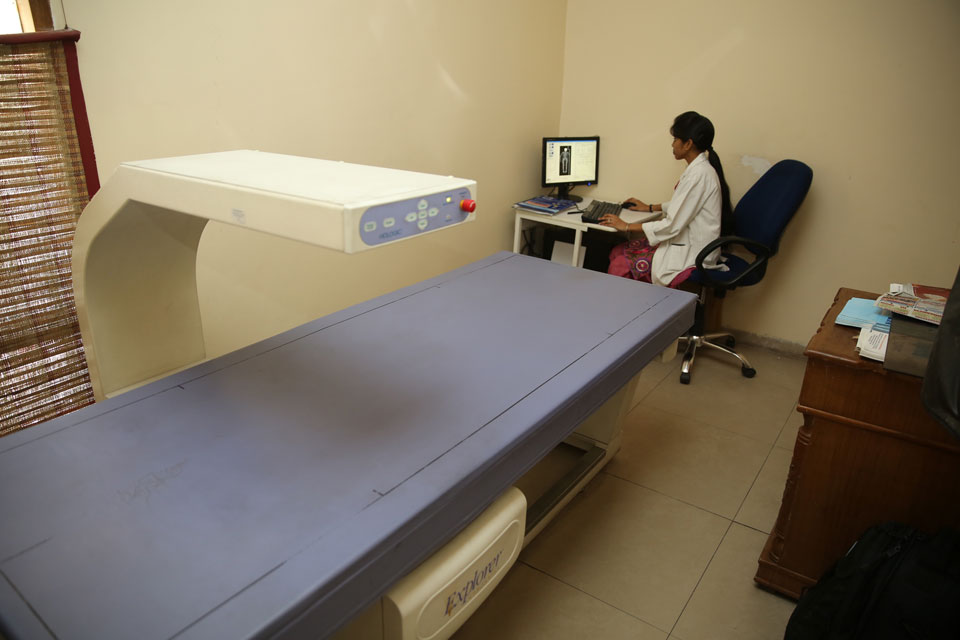DEXA(dual energy x-ray absorptiometry)
 What Is a DEXA Bone Densitometry Exam?
What Is a DEXA Bone Densitometry Exam?
DEXA (dual energy x-ray absorptiometry) is the gold standard for osteoporosis detection. Bone densitometry is a safe, painless study that measures the amount of bone mineral content in specific areas of the body. The exam uses small amounts of x-ray to produce images of the spine or wrist where most osteoporotic fractures occur. A computer determines from these differences how much bone mineral is present.
By measuring bone mineral density, a DEXA scan provides information on bone health that is used to:
- • Detect the presence of osteoporosis in men and women with particular risk factors
- • Screen for osteoporosis, particularly in women making decisions about hormone replacement therapy at menopause
- • Predict future fracture risk so prevention therapy can be started
- • Monitor bone density in those with low normal levels and in those with osteoporosis undergoing treatment
The amount of radiation a DEXA scan emits is only a fraction of that received during a standard chest x-ray. Although exposure is very low, be sure to inform the technologist if there is a chance of pregnancy.
- • Unless instructed otherwise, eat normally on the day of the scan. Avoid taking calcium supplements for at least 24 hours prior to your scan.
- • Wear loose, comfortable clothing. Sweat suits and other casual attire without zippers, buttons, grommets or any metal are preferred.
- • You should not have had a barium study, radioisotope injection, oral or intravenous contrast material from a CT scan or MRI within seven days prior to your DEXA test.
DEXA bone densitometry is a simple, non-invasive procedure. Once on the table, you may be asked to hold an awkward position for a short time while the arm of the machine passes over your body taking measurements. It is important that you stay as still as possible during the procedure to ensure a clear, useful image. No anesthesia is required. The procedure is painless, and radiation exposure is minimal.
Osteoporosis is a disease characterized by low bone mass and structural deterioration of bone tissue which leads to reduced bone strength, poor bone quality and an increased risk of fractures, especially of the hip, spine and wrist. Osteoporosis symptoms are rarely evident until significant bone loss has occurred. The disease, however, is treatable and preventable. Early diagnosis and monitoring through bone density testing allows for therapeutic intervention and has improved the prognosis for patients.
The disease poses a major public health threat for more than 50% of people over age 50. While women make up 80% of those with the disease, it is clearly not just a women’s issue. All adults should consider having a bone density test around age 35. This would provide an objective baseline against which future bone status can be compared.
Certain people are more likely to develop osteoporosis than others. The following factors increase the likelihood of developing the disease and incurring bone fractures:
- • Personal history of fracture after age 50
- • Current low bone mass
- • Being female
- • Being thin and/or having a small frame
- • Advanced age
- • A family history of osteoporosis
- • Estrogen deficiency as a result of menopause, especially early or surgically induced
- • Abnormal absence of menstrual periods (amenorrhea)
- • Anorexia nervosa
- • Low lifetime calcium intake
- • Vitamin D deficiency
- • Use of certain medications (corticosteroids, chemotherapy, anticonvulsants and others)
- • Presence of certain chronic medical conditions
- • Low testosterone levels in men
- • An inactive lifestyle
- • Current cigarette smoking
- • Excessive use of alcohol
By age 20, the average woman has acquired 98 percent of her skeletal mass. The best defense against developing osteoporosis later in life is to build strong bones during childhood and adolescence. The following lifestyle habits can optimize bone health and help prevent osteoporosis:
- • A balanced diet rich in calcium and vitamin D
- • Weight-bearing and resistance-training exercises
- • A healthy lifestyle with no smoking or excessive alcohol intake
- • Talking to one’s healthcare professional about bone health
- • Bone density testing and medication when appropriate
